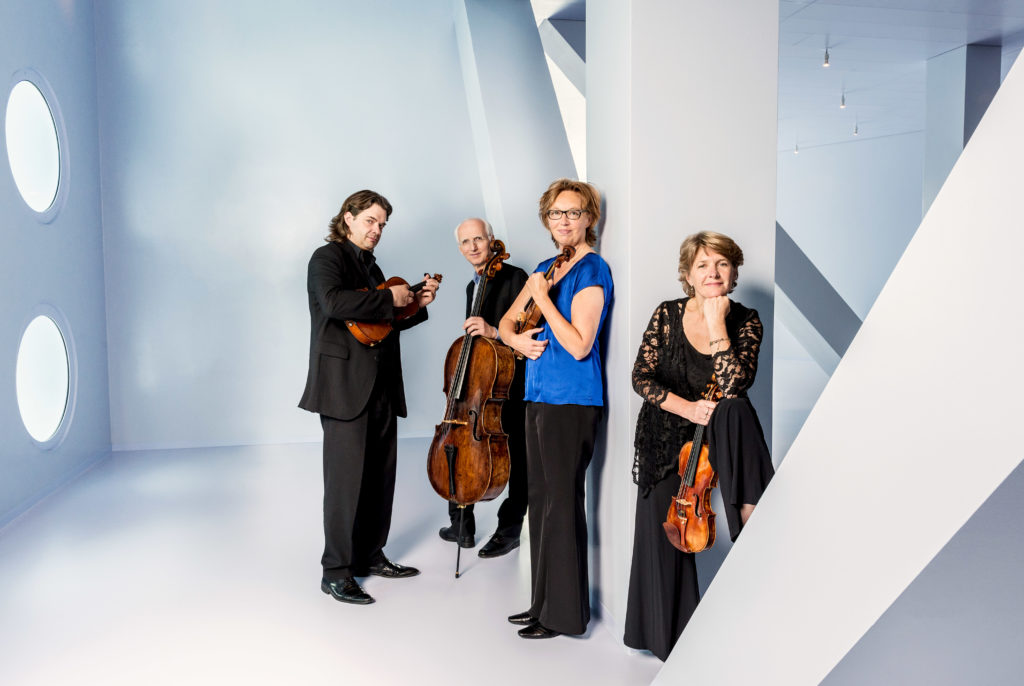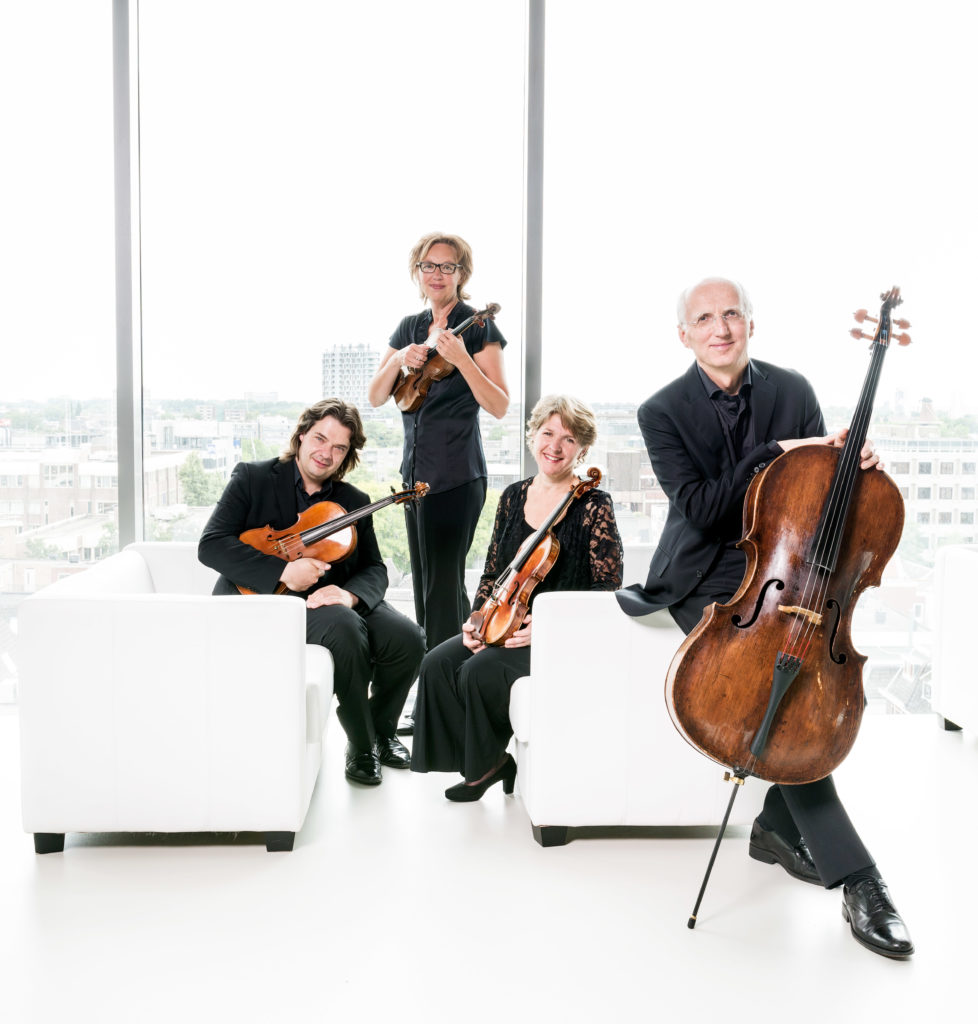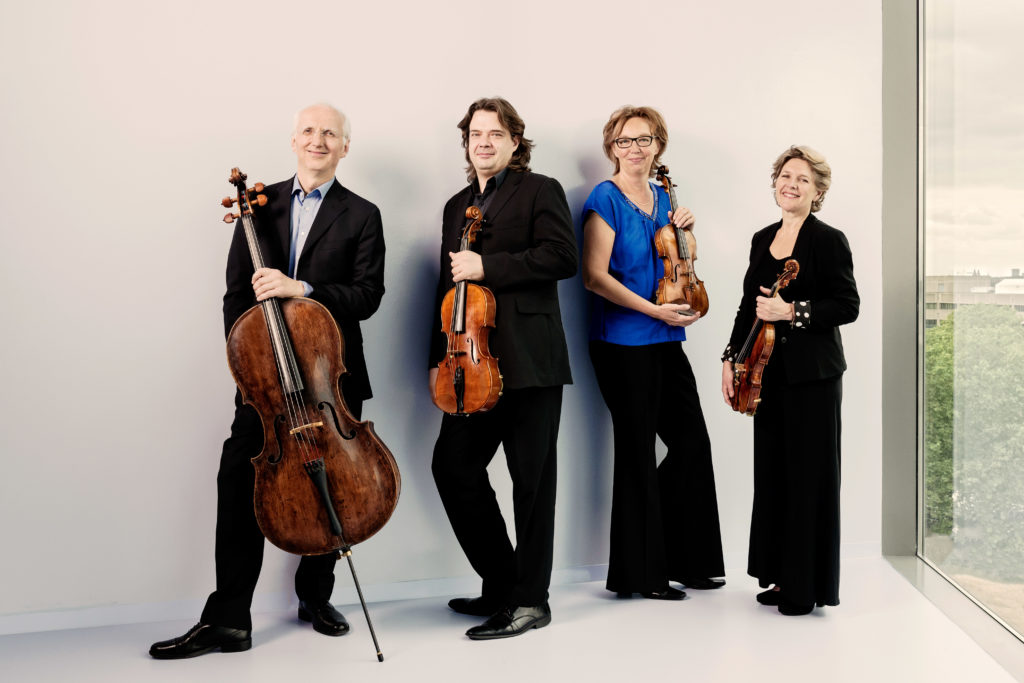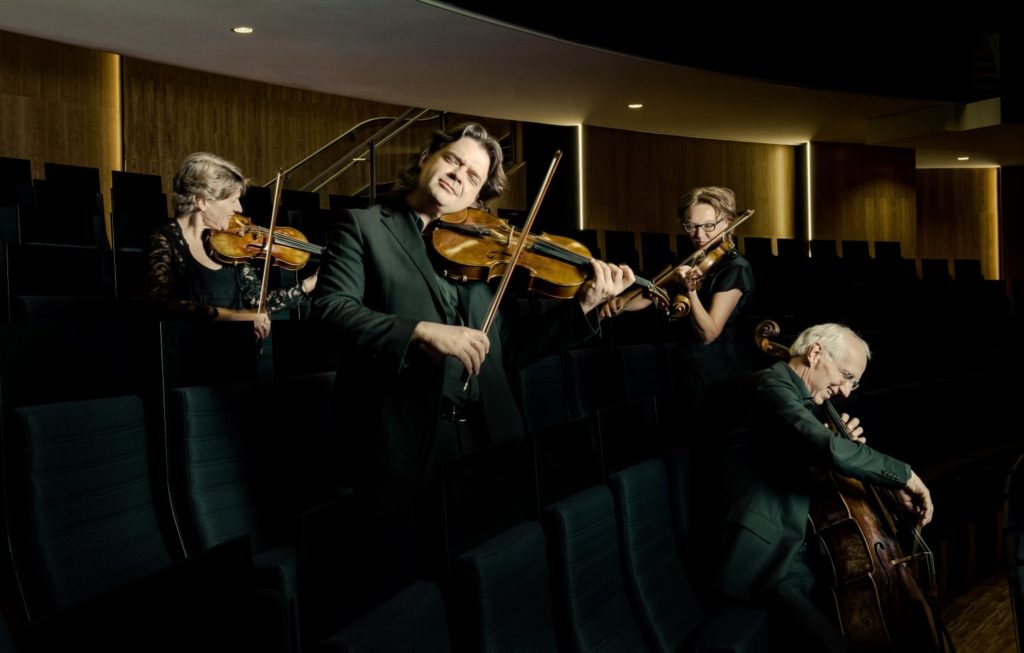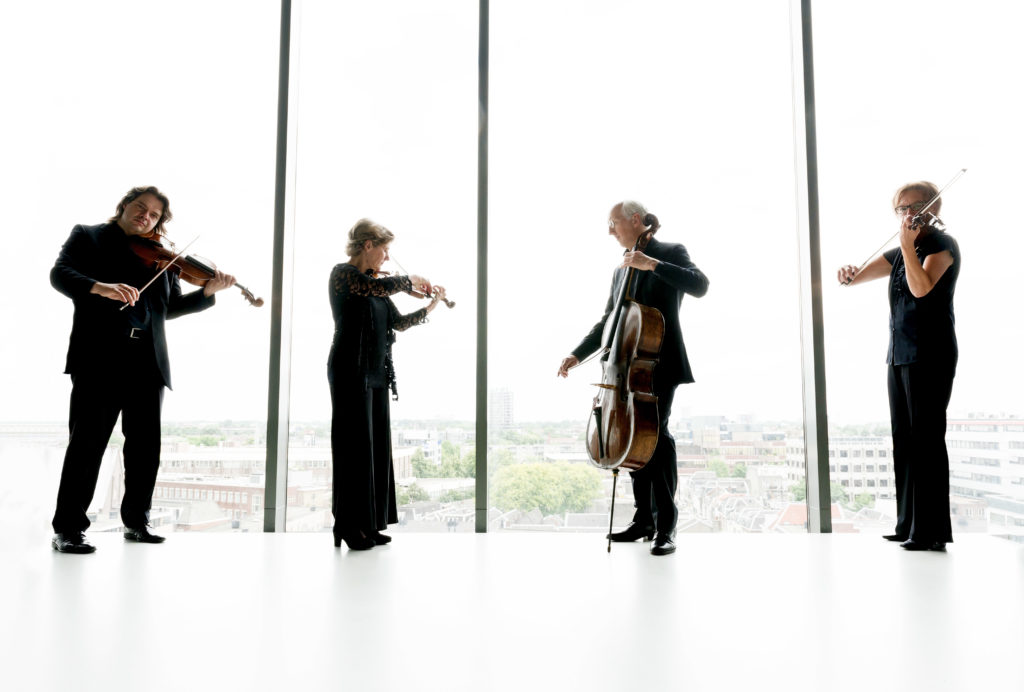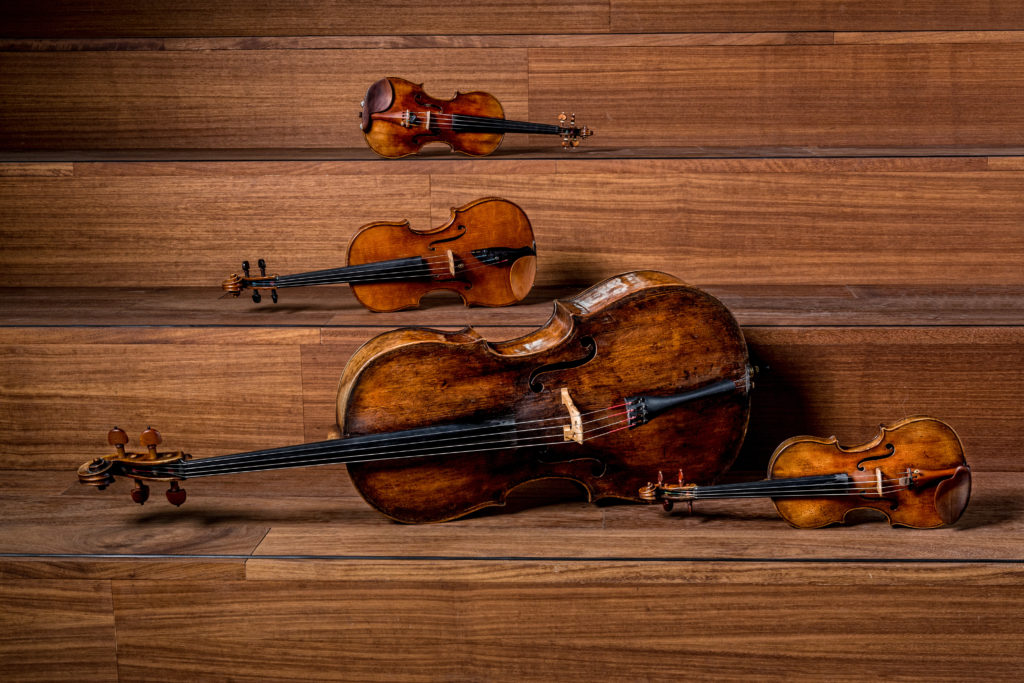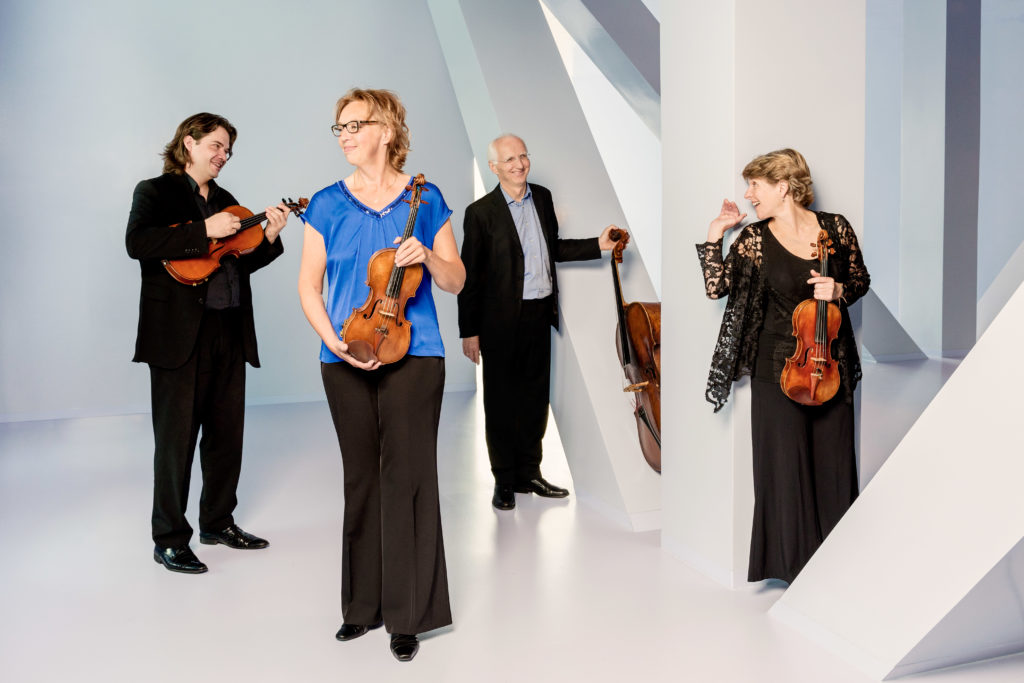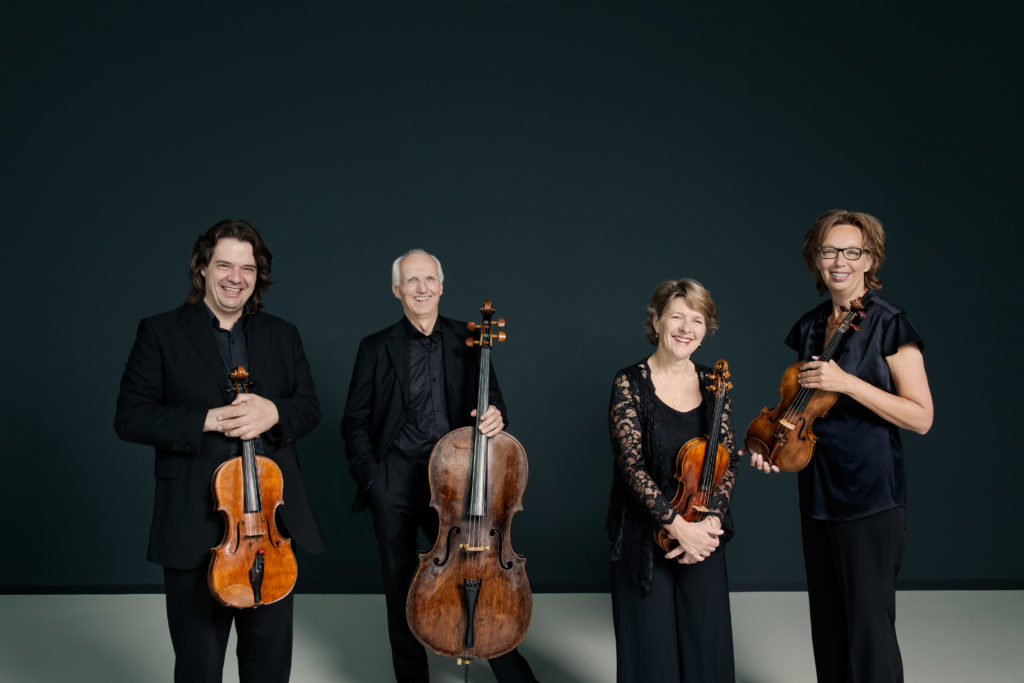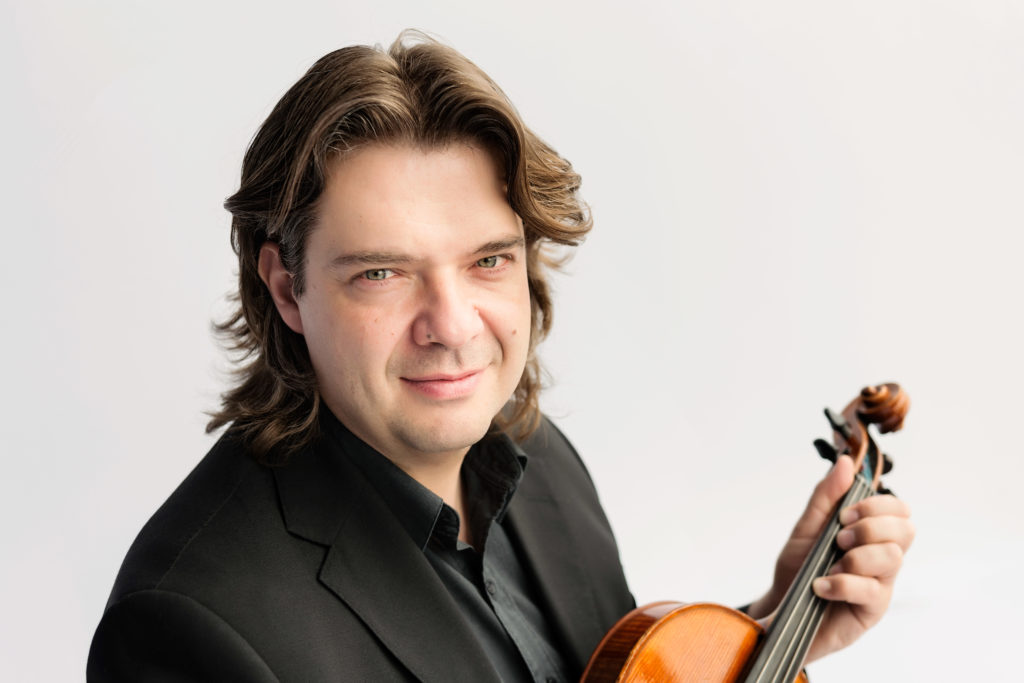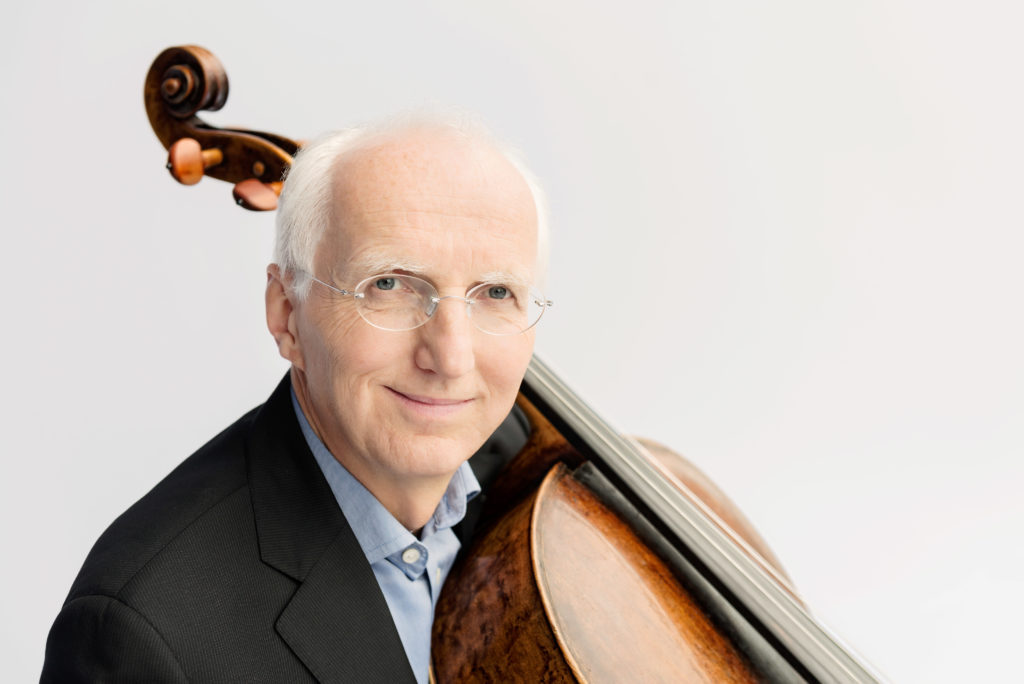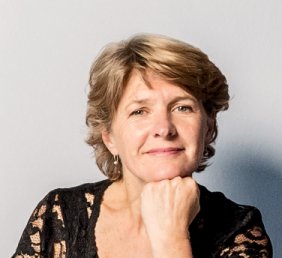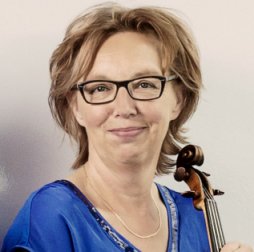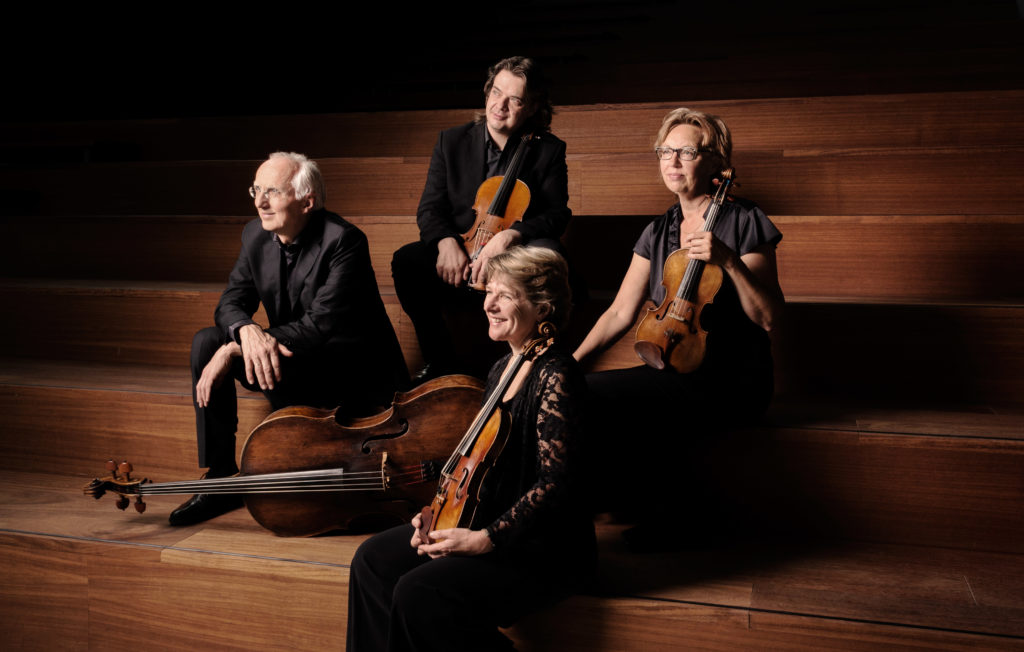
“This concert was worth waiting for […] richly colored and intensely dramatic performance” The New York Times
“…the long-established Utrecht players are in every way outstanding” The Strad
The Utrecht String Quartet is an international group, with Utrecht as the binding factor. Violinists Eeva Koskinen and Katherine Routley are from Finland and Australia respectively, viola player Mikhail Zemtsov from Russia and cellist Sebastian Koloski from Germany. Founded in 1985, the quartet has been passionately playing the timeless masterpieces of the great composers for decades, but has also specialized in tracing lost and wrongly forgotten repertoire.
Biography
The Utrecht String Quartet is an international company, with Utrecht as a binding factor. The violinists Eeva Koskinen and Katherine Routley come from Finland and Australia respectively, viola player Mikhail Zemtsov from Russia and cellist Sebastian Koloski from Germany. All of them have been living in the Netherlands for a long time and are teachers at the Utrecht Conservatoire, where they are quartet-in-residence and organize international chamber music masterclasses in collaboration with Utrecht University Summer School.
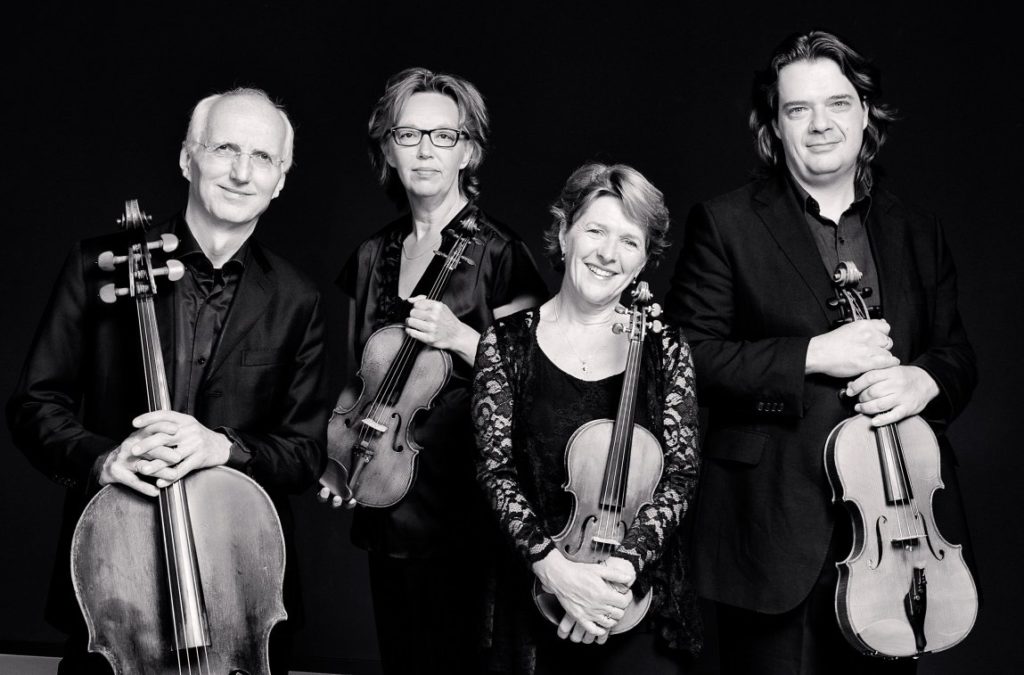
Founded in 1985, the quartet has been playing the most beautiful chamber music for decades with great passion, worldwide and on the most important (and also smaller) stages in the Netherlands. They enjoy playing the timeless masterpieces of the great composers, but have also specialised in tracing lost and unjustly forgotten repertoire and in collaborating with contemporary composers. The quartet’s mission led, among other things, to the recording of a large number of CDs for the leading German label MDG, with music by Sweelinck, Bosmans and Mosolov, the complete Early String Quartets (1928-1936) by Britten and the complete works for string quartet by Verhulst, Glazunov, Grechaninov, Lourié and Tchaikovsky.
There have been many enthusiastic reviews of these CD’s, including in 2012 in Gramophone: “I don’t remember a better-sounding string quartet recording… you’ll admire its fullness and resonance, and sharp focus that helps retain a sense of intimacy. A large part of this success is due to the players; their rich tone and blended sonorities make the most of Tchaikovsky… A top-class modern recording.” And in 2015 in Fanfare, about Verhulst’s string quartets: “…the Utrecht Quartet plays at the highest level of technical mastery and musical excellence. Based on their assured, impeccable performances here, I’d expect their Beethoven, Schumann, or anything else from the standard literature to be played on the level of the best of the world’s quartets”.
The four musicians find each other in their deepest motivation to make chamber music: to create a fantastic experience that touches people’s hearts, based on the most beautiful music of exceptional composers. The youthful bravura of the early period is enriched after thirty-five years with the power of intense togetherness and insight. “It feels like coming home when we meet again between all the other musical activities at a rehearsal or performance of the quartet. We cherish the fact that we can merge our own individual voices into a whole, we have learned to feel each other with few words”.
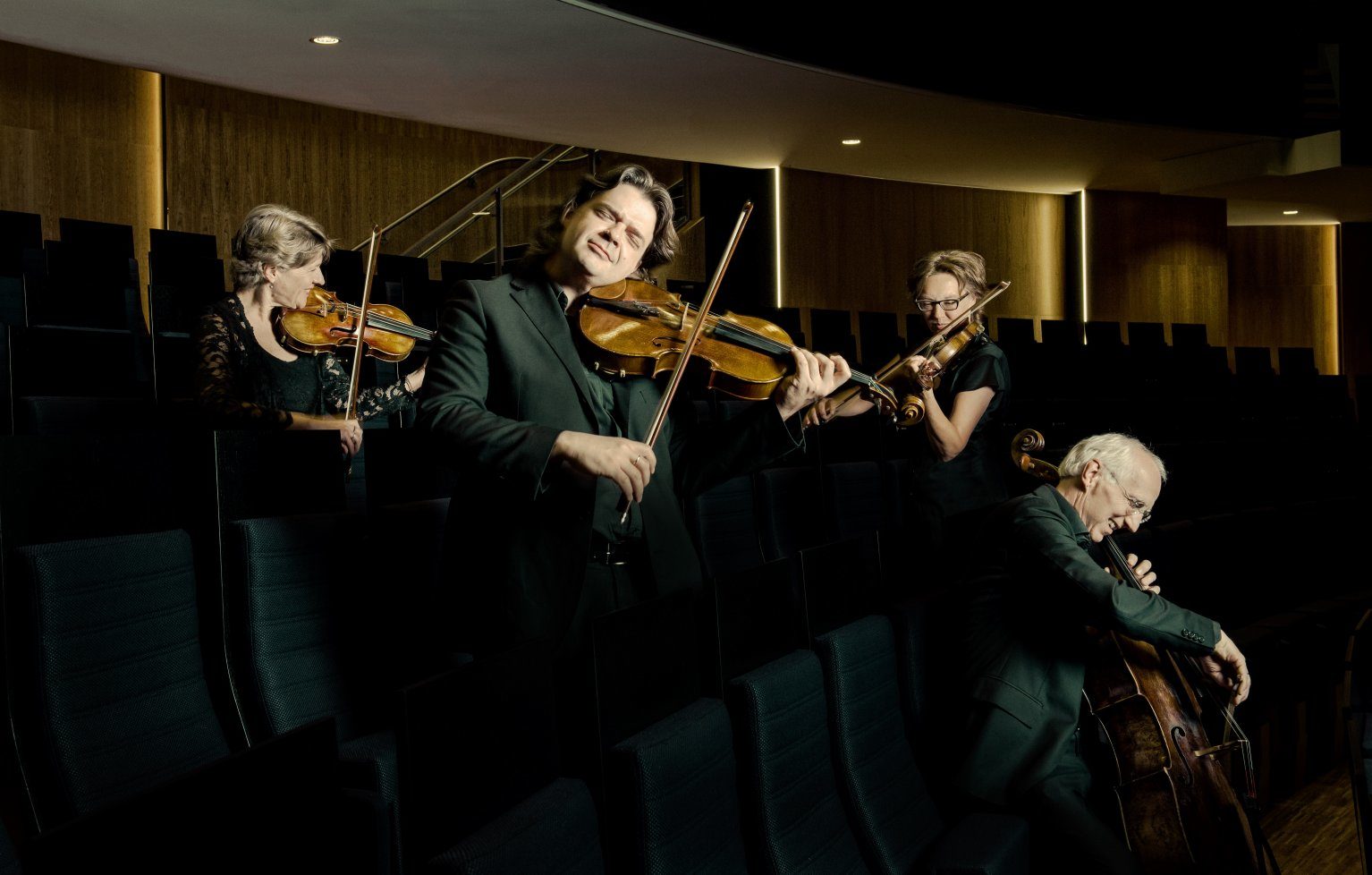
In the preparations for a first performance, Eeva, Katherine, Mikhail and Sebastian approach the music as a ‘riddle’ that needs to be solved. “If we are going to play new music, we cannot wait to discover it, understand it, and experiment with it. We look for the best tempi, harmonies and dynamics. We discuss the composer’s intentions with each other, we listen to the music, discover the possibilities and learn continuously”.
The quality and versatility of the quartet is also evident in the successful international concert tours they have made to Spain, Finland, Kazakhstan, Canada, the USA and Australia, among others. In 2013, the New York Times wrote about a concert in the Frick Collection: “This concert was worth waiting for. Their performances on Sunday, especially an engrossing account of Sibelius’ deeply personal and visionary Quartet in D minor, ‘Voces Intimae’ stood out for the vitality, immediacy and character of the music making. In a richly colored and intensely dramatic performance, the Utrecht players conveyed the captivating strangeness of this brooding, mercurial 30-minute work”.
The quartet is also a regular guest during the summer weeks of the famous Canadian Music Centre CAMMAC. USQ: “We want to share our passion and the art of playing chamber music with a younger generation. In the current calendar year, tours to Spain and Canada, among others, and a special concert at the prestigious Elbphilharmonie in Hamburg are again on the programme”.
In addition to the ‘pure’ quartet repertoire, the Utrecht String Quartet also regularly plays works from the chamber music repertoire for slightly larger ensembles, such as piano quintet, string quintet and string sextet. To this end, the quartet has built up thriving collaborative relationships with renowned musicians such as Paul Cassidy, Severin von Eckardstein, Paolo Giacometti, Nobuko Imai, Aleksander Madzer, Thomas Oliemans, Ralph van Raat, Pieter Wispelwey and Alexander and Dana Zemtsov.
Musicians

After her studies at the Sibelius Academy in her hometown Helsinki, Eeva Koskinen moved to the Netherlands to complete her training with Viktor Liberman at the Utrecht Conservatoire. During her studies she also travelled frequently to France to study with violinist Vladimir Spivakov. Eeva has won prizes at various competitions such as the Tibor Varga Competition and the Japan Music Competition, and regularly performs both nationally and internationally as a soloist and as a chamber musician. She is co-founder of the USQ. In 2001, she was appointed first concertmaster of the Noord Nederlands Orkest. Eeva is also a member of the Trio Finlandia and is a teacher at the Utrecht Conservatoire.

The Australian violinist Katherine Routley studied at the Conservatory of Music in Sydney, Indiana University in Bloomington (U.S.A.) and the Utrecht Conservatoire. She has been taught by Harry Curby, Yuval Yaron, Stanley Ritchie, Viktor Liberman and Philip Hirshhorn, among others. She has won various prizes and scholarships, which have enabled her to continue her studies outside Australia. Her love for chamber music brought her into contact with Walter Levine, Felix Ayo, Eli Goren, Sandor Végh and Gidon Kremer. Katherine is co-founder of the USQ and has also been a member of the Deutsche Kammerphilharmonie Bremen since 1989.
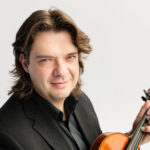
Mikhail Zemtsov received his first violin lessons from his mother Loudmila Levinson and continued his studies at the Tchaikovsky Conservatory in Moscow (viola and composition). He obtained his diplomas as a soloist with distinction at the Associated Board of the Royal Schools of Music (B. Dinerstein), the Hochschüle für Musik in Hamburg (M. Nichetianu) and the Maastricht Conservatoire (M. Kugel). Mikhail took conducting classes and master classes with Lev Markiz, Juozas Domarkas, Neeme and Paavo Järvi, Gianandrea Noseda and Daniel Raiskin. Mikhail plays with guitarist Enno Voorhorst in the Duo Macondo and founded the Zemtsov Viola Quartet with his wife Julia, his brother Alexander and his daughter Dana. He teaches at the conservatories of The Hague and Utrecht, where he also conducts the string orchestra.
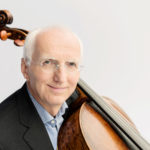
Sebastian Koloski was born in Bremen (Germany). He studied cello at the Musikhochschule Freiburg with Christoph Henkel and completed his studies in the U.S.A. with Aldo Parisot. After his return to Europe he regularly played as a freelance cellist with the Berlin Philharmonic. Sebastian now lives in the Netherlands where he was co-founder of the USQ. In addition to his intensive work as a chamber musician, he is also a freelance cellist with the Dutch Philharmonic Orchestra and is a member of the Orquestra de Cadaqués in Spain. Sebastian is head of the chamber music department at the Utrecht Conservatoire.
Programs
1. Beethoven: A life in string quartets
Beethoven: String Quartet in D, op. 18/3
Beethoven: String quartet in e minor, op. 59/2
Beethoven: String Quartet in F, op. 135
With the six string quartets op. 18, which he composed at the age of 28, Beethoven took up the challenge to compete with his teacher Haydn. When 36-year-old Beethoven wrote the string quartets op. 59 he no longer had to look up to his predecessors. The very last composition Beethoven completed, op. 135, was also a string quartet. His head was still full of ideas, but completing it took the tired composer a lot of effort. When he finally succeeded, he wrote a motto above the last movement:
‘Muss es sein? Es muss sein!’
2. John Adams: ‘Absolute Jest’ + Gustav Mahler: Symphony n.10
Adams: Absolute Jest (2011) for string quartet and orchestra
Márquez: Danzón No. 2
Holst: Japanese Suite
Respighi: Pini di Roma
The Utrechtsch Studenten Concert gained national fame in 2018 with their performance of Jan van Gilse’s opera Thijl in Military Museum Soesterberg. The excellent orchestra, which has been in existence since 1823, performs a composition by the contemporary composer John Adams, conducted by Bas Pollard, together with the Utrecht String Quartet. Adams was inspired by Beethoven and used quotes from (mainly) his late string quartets for a very surprising orchestral work. The USConcert complements the programme with the festive Pini di Roma by Respighi, the enchanting Japanese Suite by Holst and the swinging Danzón by Márquez.
3. The two Viennese schools
Webern: String quartet Langsamer Satz
Beethoven: String Quartet in D, op. 18/3
Webern: Bagatelles op.9
Beethoven: String quartet in F, op. 135
The Haydn – Mozart – Beethoven generation is called the First Viennese School. At the beginning of the twentieth century, when Arnold Schoenberg and his pupils Alban Berg and Anton Webern took a completely new direction, the label Second Viennese School was soon coined. Discover the differences!
4. The Russian inside of Beethoven
Webern: String quartet Langsamer Satz
Kabalevsky: String quartet nr.1
Beethoven: String quartet in e minor, op. 59/2
Beethoven wrote three string quartets commissioned by Count Razumovsky. To please his client, he used a popular Russian theme in the second quartet. Dmitri Kabalevsky – who grew up with the dogmas of socialist realism – also used Russian folk music in his work. The ‘Langsamer Satz’ dates from before Webern’s atonal period.
5. Viennese virtuosity and Argentine melancholy
Beethoven: String quartet in e minor, op. 59/2
Piazzolla/E. Zemtsov: Las cuatro estaciones Porteñas
In his late string quartets, Beethoven did not take into account any technical limitations of his players. Even the grumbling of the virtuoso Schuppanzigh could count on little compassion. Composer Evgeny Zemtsov turned Piazzolla’s ‘Four Seasons of Buenos Aires’ into a masterly arrangement for string quartet.
6. Romanticism and revolution
Beethoven: String Quartet in D, op. 18/3
or Verhulst: String Quartet no. 1 in d minor, op. 6/1
Szymanowski: String Quartet No. 1 in C, op. 37
Glazunov: String quartet no. 5 in d minor, op. 70
Will you choose Beethoven or do you grant Johannes Verhulst a chance? The Utrecht String Quartet played the first string quartet of this unjustly forgotten Dutch composer from New York to Kazakhstan. And everywhere, the audience was enthusiastic! While Szymanowski was writing his first string quartet, the Russian revolution in 1917 destroyed his family estate. In the last movement the composer winkles at Beethoven’s Fifth Symphony. Exciting and dreamy passages alternate. Glazunov’s Romantic Fifth String Quartet is packed with the most beautiful melodies.
7. Roaring twenties
H. Bosmans: String Quartet
British: String quartet no. 3 in G, op. 94
Barber: String quartet in b minor, op. 11
Bartók: String quartet no. 3
For the birthday of her colleague Willem Pijper, Henriëtte Bosmans wrote music that breathes the zest for life of the ‘roaring twenties’. Half a century later, Britten composed his last poignant notes. He died two weeks before the premiere of his third string quartet. Shortly after the completion of his string quartet, Barber wrote: “I have just finished the slow part of my string quartet – It’s a knockout!” It became known as the world famous Adagio for Strings. Bartók went into the mountains with a phonograph to record folk music. In his third string quartet he incorporated his impressions. Rhythmic fireworks from Hungary!
8. Début-de-siècle Wien
Zemlinsky: String quartet no. 1 in a minor, op. 4
Kreisler: String quartet in a minor
Webern: Sechs Bagatelles, op. 9
Korngold: String quartet no. 2 in E flat, op. 26
In the vibrant Vienna at the beginning of the twentieth century, late Romanticism sounded alongside the new music of Schoenberg and his pupils. In Zemlinsky’s quartet you can still hear a bit of Brahms, in Korngold’s quartet the Hollywood sound he developed is already forerunners. In America, Kreisler wrote a string quartet full of nostalgia for Vienna. After the ‘Anschluß’ at Nazi Germany, the three had to leave Vienna. Schoenberg’s pupil Webern represents a completely different, but no less Viennese sound: with few notes he conjures up a world of his own.
Utrecht String Quartet & friends
9. Double dose of viola
Utrecht String Quartet & Alexander Zemtsov or Dana Zemtsov, viola
Sweelinck: Chromatic Fantasy (arrangement for string quartet B. van den Sigtenhorst Meyer)
Mozart: String quintet in c minor, KV 406
Taneev: String quintet no. 2 in C, op. 16
Organ virtuoso Sweelinck would probably have been pleasantly surprised if he had heard how his Chromatic Fantasy blossoms in the version for string quartet. Mozart loved the viola so much that he used two in his string quintet in c minor. On the threshold of the twentieth century, Sergey Taneev followed his example and wrote a masterpiece for this instrumentation. However, the aristocratic composer was not liked by the Soviets and his music was forgotten. The Utrecht String Quartet shows why Taneev absolutely belongs in the list of great Russian composers.
10. Vienna and Paris
Utrecht String Quartet & Paolo Giacometti, piano
Debussy: La Cathédrale Engloutie, l’Isle Joyeuse (piano solo)
Fauré: Piano quintet no.1 in d minor, op. 89
Webern: Langsamer Satz (string quartet)
Korngold: Piano Quintet in E, op. 15
For almost twenty years, Gabriel Fauré has been contemplating his piano quintet in d minor, the first sketches dating from the time he worked on his famous Requiem. Fauré was a humble pianist and gave the piano a role equal to that of the strings. No pianistic caprioles in this contemplative and somewhat melancholic work. Erich Wolfgang Korngold is best known for the film music he composed for major Hollywood productions. Far less well known is that before his forced emigration to America – as a Jew he had no chance in Vienna after the ‘Anschluss’ in 1938 – he was a promising classical composer, admired by Mahler and Strauss. Besides Strauss, he even was the most frequently performed opera composer in the twenties. As a pupil of Arnold Schoenberg, Webern would become a prominent member of the Second Viennese School, known for its use of the twelve-tone technique. However, the one-part string quartet from 1905 predates this era and was not published until years after his death. On the manuscript a young Webern wrote a quote from the 16th century: ‘I cannot describe the feeling of triumph that manifested itself in my mind. It can’t be compared to anything except the emergence of new life in the depths of death, like the resurrection’. Paolo Giacometti plays two works by Claude Debussy for piano solo.
11. Fin-de siècle Paris
Utrecht String Quartet & Jeroen de Groot, violin and Paolo Giacometti, piano
Debussy: String quartet in g minor, op. 10
Franck: Sonata for violin and piano in A
Chausson: Concert for violin, piano and string quartet in D, op. 21
Let yourself be carried away by the elegant sounds of Parisian musical life at the end of the nineteenth century with works dedicated to violin virtuoso Eugène Ysaÿe. Franck dedicated his famous violin sonata to him. In 1892, his pupil Chausson wrote in his diary that he had never experienced such success as at the premiere of his Concert for violin, piano and string quartet. Ysaÿe’s playing will have contributed greatly to this. Colleague Debussy followed a year later with his highly original string quartet, also performed by a quartet led by Ysaÿe.
12. 250 years Beethoven: Vienna and Paris (2)
Utrecht String Quartet & Jeroen de Groot, violin and Paolo Giacometti, piano
Beethoven: String Quartet in D, op. 18/3
Beethoven: Sonata for violin and piano no. 9 in A, op. 47 “Kreutzer”
Chausson: Concert for violin, piano and string quartet in D, op. 21
Chausson’s passionate Concert for Violin, Piano and String Quartet can also be perfectly combined with Beethoven’s lively string quartet and the spectacular Kreutzer Sonata. After a thorough study of his illustrious predecessors Haydn and Mozart, the string quartet in D – although third in the series – was Beethoven’s first test in the genre. Three years later he wrote above the sketches for his violin sonata. 9 ‘in very concertante style, as if it were a concert’.
13. Fandango
Utrecht String Quartet & Izhar Elias, guitar
Boccherini: Guitar Quintet No. 4 in D, G.448 “Fandango”
Mendelssohn: String quartet no. 3 in D, op. 44/1
Henriëtte Bosmans: String Quartet (1927)
Castelnuovo-Tedesco: Guitar Quintet, op. 143
A programme full of exhilarating passion and boundless optimism. The Italian Boccherini composed at the Spanish court for guitar and mastered the fandango, an exhilarating Spanish dance. Mendelssohn was excessively happy when he composed his third string quartet and you can hear that. The music bursts at the seams of joy and optimism. The energetic last part of the string quartet by Henriëtte Bosmans fits in wonderfully well with it. Her contemporary Mario Castelnuovo-Tedesco became addicted to the guitar after a musical encounter with guitarist Andrés Segovia. His quintet is one of the most beautiful and virtuoso chamber music works with guitar.
14. Seasons of nature
Utrecht String Quartet & Dana Zemtsov, viola and Alfredo Oyagues, piano
Piazzolla: Invierno Porteno (arr. E. Zemtsov)
Granados: Piano quintet in g, op. 49
Piazzolla: Primavera Porteno (arr. E. Zemtsov)
Turina: Escena Andaluza, for viola and piano quintet
Piazzolla: Verano Porteno (arr. E. Zemtsov)
Schäfer: Adagio from Pianokwintet op. 5
Piazzolla: Otono Porteno (arr. E. Zemtsov)
Turina: Oracion del Torero, op. 34
Piazzolla: Grand Tango, for viola and piano quintet (arr. E. Zemtsov)
Evgeny Zemtsov, the father of viola player Mikhail, fell under the spell of the tango after a composition assignment. “At one point, my father knew everything about the tango and from that moment on, he worked on the arrangement of Piazzolla’s Las Cuatro Estaciones Porteñas for fifteen years. Piazzolla composed the Grand Tango for cellist Rostropovich, Evgeny Zemtsov arranged this piece for his granddaughter Dana. In this programme there is also music by two Andalusian composers: Enrique Granados and Joaquín Turina. The compelling Adagio from the piano quintet by the Dutch composer Dirk Schäfer fits wonderfully well into this temperamental programme.
Repertoire
Classical / (late) romantic
J. Haydn String Quartet op.33/5, op.20/3, op.103
W.A. Mozart String Quartet KV 465 (Dissonant) KV 421
Chr. de Arriaga String Quartet nr. 3
L. Boccherini String Quartet op.2 nr.1
L.v. Beethoven String Quartet op. 18/1-4, op.74, op.135, Quintet op.29
F. Schubert p.168, “Death and the Maiden”
F. Mendelssohn String Quartet op.13, op.81
R.Schumann String Quartet nr.2
J. Brahms String Quartet nr. 1
B. Smetana From my life
A. Dvorák String Quartet op.51, op.96 American
A. Glazunov String Quartet nr. 1-7, Suite op.35, Quintet op.39
A. Grechaninov String Quartet nr. 1-4
A. Tanejew String Quintet op.14, op.16
P.I. Tschaikovsky String Quartet nr. 1-3, Album for the Youth op.39
J. Sibelius Voces Intimae
Dutch
J.B.v.Bree String Quartet nr.1
J.Verhulst String Quartet nr.1-2
C. Michans Octet (2002), Dravidian Moods (2007)
H. Bosmans String Quartet (1927)
H. Kox String Quartet (1955)
J.P. Sweelinck Chromatische Fantasie
J.P. Sweelinck / C. Meijering Mein junges Leben hat (k)ein End (2007)
L. Smit String Quartet(1940)
L. van Delden String Quartet nr. 1-3(1954-1979)
N. Richter String Quartet (1941)
Oscar van Hemel String Quartet nr.4
B. de Roos String Quartet nr. 3
W. Kes String Quartet (1891)
20th/21st CENTURY
A. Esphay Concordia Discordans
A. Lourié String Quartet nr. 2
A. Mosolov String Quartet nr. 1
A. Sallinen String Quartet nr. 3
B. Bartók String Quartet nr. 1-6
B. Britten Early string quartets 1927 – 1936
B. Britten String Quartet nr.3
D. Schostakovitsch String Quartet nr. 9, nr. 11, Adagio & Allegro
E. Carter String Quartet nr. 1
E. Toldra Vistas del mar (Spain)
G. Klein String Quartet nr. 2
G. Ligeti String Quartet nr. 2
G. Crumb Black Angels
J. Kokkonen String Quartet nr. 2
L. Auerbach String Quartet nr. 1
P. Eötvös Korrespondenz
Uljas Voitto Pulkkis Nachtlieder (2003)
V. Ullman String Quartet nr. 3, op. 46
W. Rihm Quartett-Studie
Photos

